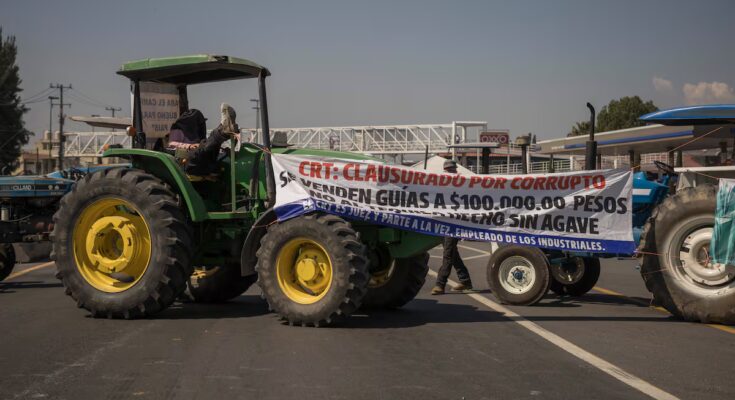On October 14, the lemons of Apatzingán, Michoacán, threw the products they had collected into the streets. Boxes and crates full of green lemons were abandoned on the streets. The then leader of the sector, Bernardo Bravo, asked in a statement for government intervention so that the Development Bank could recover preferential tariffs for producers, regularize agricultural wells and increase public policies to relaunch the countryside. They also opposed the “coyotes”, intermediaries who increase the prices of products before they reach the buyers’ homes, which is why they wanted to organize days of direct negotiations with the packers. Likewise, they called for security for all businessmen.
At one meeting they said that production costs would not be offset by purchasing the product, so they would try to sell it directly to power plants and other distributors. Just five days after the meeting, Bernardo Bravo was assassinated. His last message was an appeal to producers to organize themselves to improve the sale of the product. Since then the demand for security has become stronger and the protests have multiplied because the taxes imposed by criminals through extortion are added to production prices.
Subsequent demonstrations have been organized mainly by corn producers, who have so far closed roads in much of Bajío, which includes Michoacán, Jalisco and Guanajuato. They made them to receive more benefits. Before the negotiations, according to the Peasant Agricultural Movement (MAC), they received an approximate payment of 4.70 pesos per kilo (25 cents). They wanted the payment to reach 7.20 per kilo, or 7,200 pesos ($390) per ton.
The Ministry of Agriculture, represented by Julio Berdegué, has started a series of negotiations to stop the road closures, the protest measure chosen by farmers to put pressure on the federal government. After choking the main national roads for a couple of days, the parties reached an agreement with the producers of Bajío. A price of 6,050 pesos per ton would be imposed, plus support of 950 pesos per ton that would be given to 90,000 producers. Crop credit and insurance will be provided, but only to corn producers in Michoacán, Jalisco and Guanajuato. This despite the demonstrations having spread to 24 states, more than two thirds of the country.
Mexico is a country of producers, in the republic according to 2024 data almost 20 million hectares are cultivated. The largest farmers, regardless of the crops they generate, are Veracruz, Jalisco, Oaxaca, Chiapas and Tamaulipas. However, Jalisco, Michoacán and Sinaloa have the highest production income.

Corn is the most common crop in the nation. In 2024 alone, 24 million tonnes were produced, on 6.5 million hectares, followed by beans, sorghum, wheat and oats. As regards perennial crops, i.e. those with very long cycles, cultivated grasses, sugar cane, coffee, oranges, alfalfa and lemons predominate.

Field working conditions
Approximately 2.8 million Mexicans engage in agricultural activities. They have an average monthly income of 2,750 pesos ($148) and dedicate about five days a week to working in the fields. Only 10% have a second job and 83% are considered informal workers, meaning they have no benefits, according to Inegi.

The southern states of the country are those that contribute the largest number of agricultural workers to the countryside, however they are the regions where the lowest wages are awarded. Agricultural workers in Oaxaca earn 815 pesos per capita per month, a low income that contrasts with day laborers in Michoacán, who receive about 5,900 pesos for the same work. The best-paid farmers are found in Baja California Sur, where they have incomes of up to 9,900 pesos, according to first-quarter 2025 data from the National Occupation and Employment Survey.
Mexican corn production and international prices
Announcing the agreement with the producers, Secretary Berdegué raised the problem that threatens corn production. As Mexico produces more, the rest of the countries do the same, so there will be more grain reserves in the coming months. According to 2022 data, the largest markets are divided between the United States (29.7%), Brazil (18.9%), Argentina (15.3%) and Ukraine (9.34%). Mexico, on the other hand, barely contributes 0.15% of international sales of the agricultural product it grows the most. However, its consumption is high. The country imports 7.8% of total international purchases, behind only China, which represents 10%, and Japan, which occupies 8%.
The current international price of corn continues to decline compared to April 2022, when it reached its highest level thanks to geopolitical tensions caused by the war in Ukraine. Data from the International Monetary Fund (IMF) pegs a price of $195.71 per ton (3,623 pesos) in July 2025, a figure not seen since late 2020.

Corn producers also highlight an issue specific to Mexico. In the country there are two large companies dedicated to the sale of flour, Minsa and Gruma, known for the Maseca brand. Until 2023 they controlled 25% of the national market, so price regulation also passes through their authority. Some producers are also calling for the removal of transgenic corn seeds, because they believe they alter the country’s regular harvests.
Guanajuato’s corn producers’ unions say the new prices granted by the Mexican government are not enough and say they will call growers in other states to demand better conditions. Among some comments of solidarity on social networks, there are also other requests from farmers from other areas and products. They call for unity to improve the entire industry and continue to hold nationwide strikes so that producers and their workers get more benefits.



